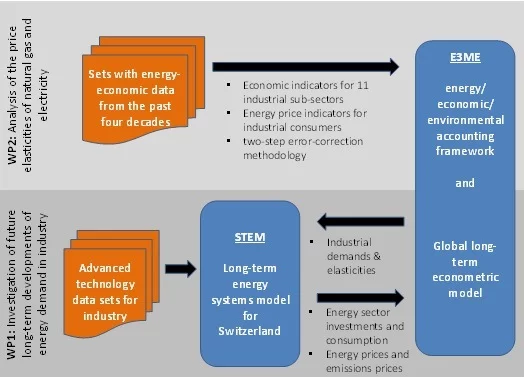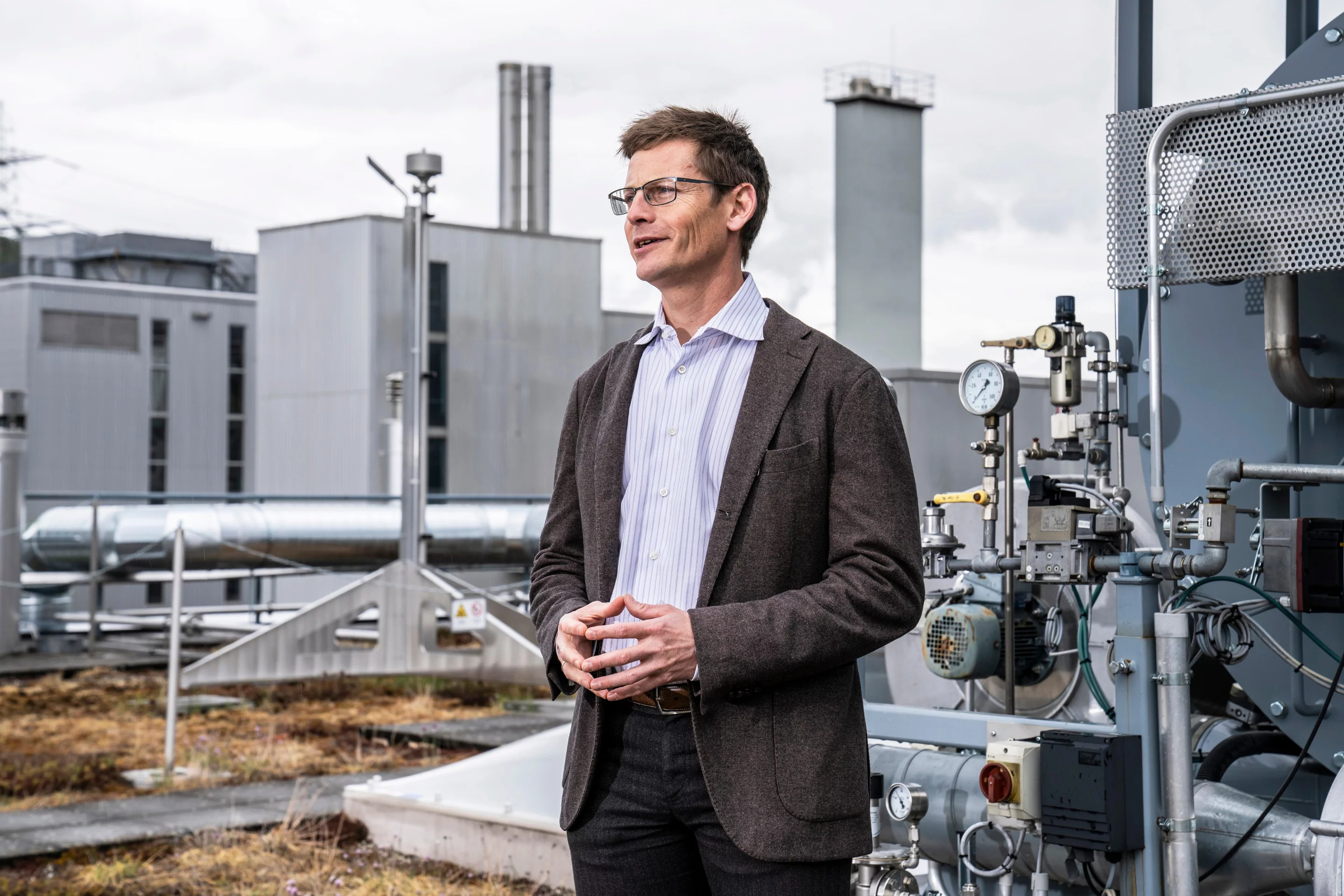In this project price elasticities of natural gas and electricity consumption for Swiss industry are investigated based on historic time series. In addition, future long-term developments of the Swiss industries’ energy demands are analysed by employing an energy-econometric accounting framework combined with a techno-economic modelling approach. Therefore, a combination of the global macro-economic model E3ME and the Swiss energy system model STEM has been applied to conduct a multi-scenario analysis scoping on the Swiss industry.
An Over view of the WP are illustrated in the figure
Project summary
The analysis of the price elasticities for electricity and gas, suggest that most Swiss industries do not reduce energy consumption in the years immediately following an increase in energy prices. However, in the longer term (i.e. around 5 years after any initial shock), we identify statistically significant price elasticities, suggesting that, in most cases, it takes time to adjust and adapt manufacturing processes and procedures or to invest in more energy-efficient equipment, following a price signal. The results also suggest considerable heterogeneity in estimated price elasticities among industry sectors. One of the sectors that is least responsive to a change in energy prices is ‘Iron & steel’, where our estimates indicate a 0.14% reduction in energy demand in the long run for a 1% increase in energy prices. By contrast, in the ‘Non-metallic minerals’ and ‘Paper and pulp’ sectors, we find that energy demand in more elastic as firms in these sectors are more responsive to a change in energy price, with an estimated price elasticity of -0.7 implying that firms in these sectors, on average, will reduce energy demand by 0.7% for a 1% increase in relative energy prices.
The scenario analysis of long-term developments of energy consumption of the Swiss industry and related energy policies reveals that the combination of general energy efficiency improvements alongside a reduction of the per-capita electricity consumption is a less cost-effective way to promote energy efficiency and to reduce CO2 emissions in industry. This leads to the conclusion that promoting an efficient use of electricity is beneficial while incentives to switch from fossil fuels to electricity-based technologies should retain. A broader roll-out of electricity-based technologies such as e-mobility, deployment of heat pumps is essential for decarbonisation of the Swiss energy system. Limiting the total amount of electricity consumed could be counter-productive and may lead to less cost-optimal emission mitigation solutions.
If a deep decarbonisation of the energy sector is achieved, the industry sector remains one of the challenging sectors for mitigation and may increase its share of the total CO2 emissions in the energy system in the long run (2050). This statement even holds if only energy-related CO2 emissions are considered, while abatement of process-related CO2 emissions depends on the availability and adaptation of some emerging technologies, such as CO2 capture technologies in the cement industry or waste incineration plants.
Electricity becomes a key energy carrier under a decarbonisation strategy, not only in industry but also in other energy end-use sectors. This not only requires a timely commissioning of new renewable energy in Switzerland but also to deploy the option of increased electricity imports. In industry, oil-products can be phased out and partly substituted by biogenic liquids and other low-carbon energy carriers as well as electricity-based heating, for instance with low temperature heat pumps in selected subsectors (especially food, and paper industries). The share of the energy intensive branches of total industrial energy consumption increases over time which indicates better opportunities to unlock energy efficiency improvements in non-energy-intensive sectors. Where possible, biogenic waste product streams should be used as an energy carrier, which not only helps to close material/product circles but also to provide low carbon fuel substitutes, as our results indicate for the food industry.
The scenario results related to the macro-economic impacts show a low to moderate impact until 2030, for both the energy policies and the climate policies analysed in this study. In the longer term, macro-economic impacts are determined significantly by the developments of the energy and carbon prices applicable to consumers. The achievement of the indicative goals of the Swiss energy policy, i.e. improving general energy efficiency while curbing the average per-capita electricity consumption, reduces Swiss GDP by 1 to 4% (2030 and 2050 respectively), equivalent to GDP growth of around 0.1 percentage points (ppt) lower than baseline over this period. Higher consumer prices, for instance as consequence of a deep decarbonisation within Switzerland with limited availability of cost-efficient decarbonisation technologies, would lead to more pronounced GDP impacts of up to 10% lower than baseline by 2050 (equivalent to an annual GDP growth rate 0.3ppt lower than baseline in each year to 2050). Again, the macro-economic impacts are highly dependent on boundary conditions, such as access to wider EU electricity markets and level of successful solar PV deployment in Switzerland. For instance, availability of more imported (low-carbon) electricity could reduce the scale of the negative economic impacts to around 3% to 4% lower than baseline by 2050 (equivalent to a 0.1ppt reduction in the annual GDP growth rate over this period).
Press release
Long-term developments of energy pricing and consumption in industry
Researchers at the Paul Scherrer Institute PSI have collaborated with British economists to study how energy consumption by Swiss industry develops depending on energy pricing. To this end, they examined in particular the prices and consumption of both electricity and natural gas over the past decades. One result: For the most part, price increases have only long-term effects on energy consumption. Furthermore, the researchers worked out possible scenarios for future development up to the year 2050 in which they address, among other things, aspects of climate protection. Today the researchers are publishing their results in the report "Swiss Industry: Price Elasticities and Demand Developments for Electricity and Gas". Read further in https://www.psi.ch/en/media/our-research/long-term-developments-of-energy-pricing-and-consumption-in-industry


